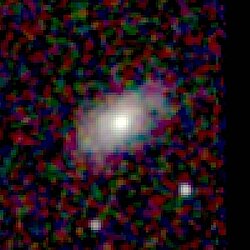| NGC 41 | |
|---|---|
 SDSS image of NGC 41 | |
| Observation data (J2000 epoch) | |
| Constellation | Pegasus |
| Right ascension | 00h 12m 47.952s [1] |
| Declination | +22° 01′ 23.96″ [1] |
| Redshift | 0.019710 [2] |
| Heliocentric radial velocity | 5851 km/s [2] |
| Distance | 286.69 ± 0.65 Mly (87.90 ± 0.20 Mpc) [3] |
| Apparent magnitude (B) | 14.6 [2] |
| Characteristics | |
| Type | Sc [4] |
| Other designations | |
| MCG +04-01-039, PGC 865 [2] | |
NGC 41 is a spiral galaxy located in the constellation Pegasus. It is located about 290 million light-years (90 Megaparsecs) away from the Sun. [3] It was discovered on October 30, 1864, by the astronomer Albert Marth.
Contents
